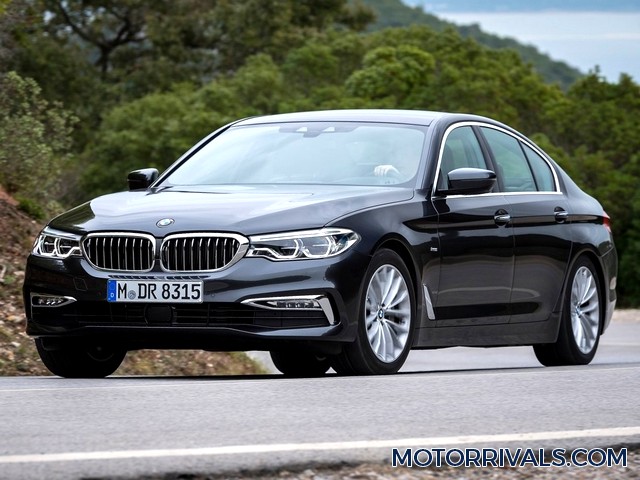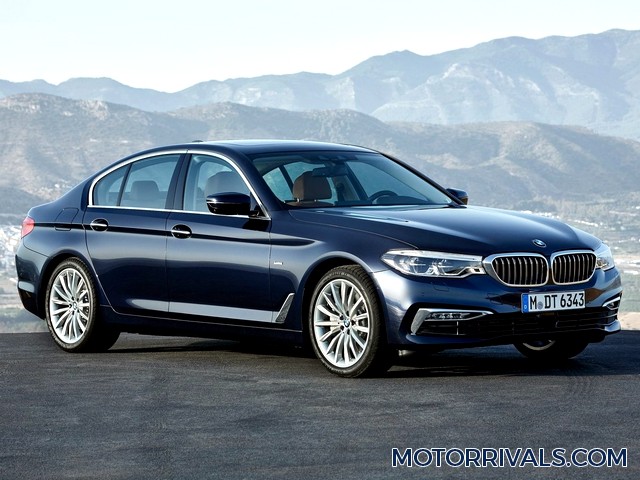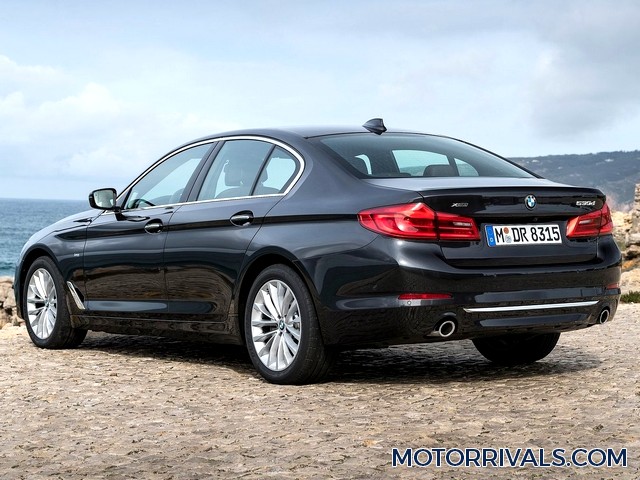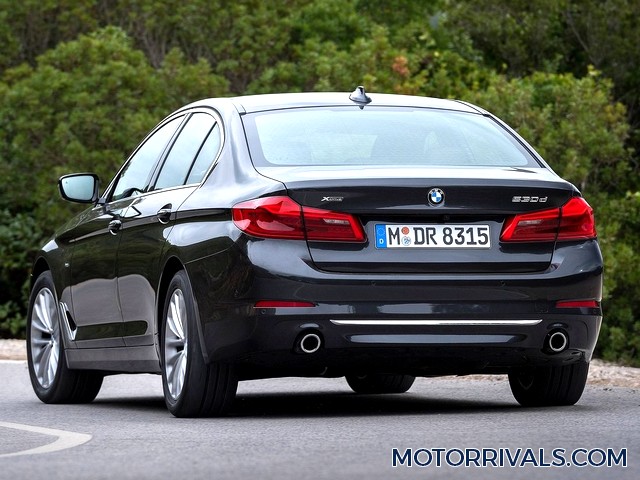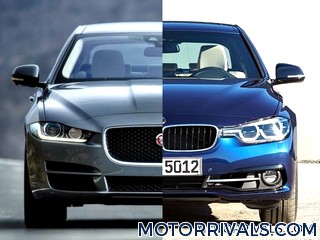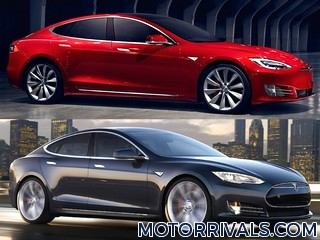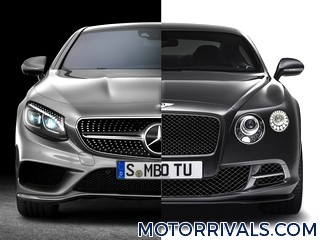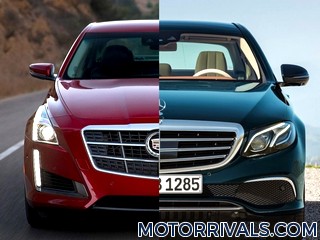2017 BMW 5 Series vs 2017 Audi A6
BMW Press Release Highlights
Powertrain
The petrol units employ TwinScroll turbocharging, High Precision Injection, Double-VANOS variable camshaft control and Valvetronic fully variable valve timing. The diesel models, meanwhile, feature a turbocharger with variable turbine geometry and latest-generation common-rail direct injection. The new two-litre four-cylinder in-line turbocharged direct injection engine in the BMW 530i delivers its peak output of 185 kW/252 hp (up 5 kW/7 hp on its predecessor). Average fuel consumption works out at 5.4 l/100 km (52.3 mpg imp). The BMW 530i sprints from 0 to 100 km/h (62 mph) in 6.2 seconds and reaches a top speed of 250 km/h (155 mph).The new BMW 540i and generates 250 kW/340 hp (+25 kW/34 hp). The three-litre straight-six musters up a mighty 450 Nm / 332 lb ft of torque (+50 Nm/37 lb-ft). Average consumption is a frugal 6.5 l/100 km (43.5 mpg imp). The sedan powers from 0 to 100 km/h (62 mph) in just 5.1 seconds and top speed is electronically limited to 250 km/h (155 mph). The all-wheel-drive BMW 540i xDrive sets a new class-beating time of 4.8 seconds for the sprint from 0 to 100 km/h (62 mph). Its fuel consumption is 6.7 l/100 km (42.2 mpg imp). A plug-in hybrid BMW 530e iPerformance generating overall output of 185 kW/252 hp and fuel consumption of 2.0 l/100 km (141.2 mpg imp) sets new standards. The BMW 530e iPerformance has an electric range of 45 kilometres (28 miles). The BMW M550i xDrive, whose V8 engine with an output of 340 kW/462 hp and maximum torque of 650 Nm (479 lb-ft) races from 0 to 100 km/h (62 mph) in 4.0 seconds with efficiency (fuel consumption combined: 8.9 l/100 km [31.7 mpg imp]. All the engines available at launch can link up with BMW xDrive intelligent all-wheel drive.
Chassis
The new double-wishbone front axle's kinematics are perfectly configured for a long-distance sedan. Light-metal components are also used extensively in the new five-link rear suspension, which is even lighter and stiffer than in the previous model and provides precise wheel location and excellent tracking stability in all driving situations. The electromechanical steering system features a variable steering ratio and speed-sensitive power assistance. The new BMW 5-Series is fitted with either single-piece or two-piece four-piston fixed aluminium callipers at the front, with lightweight discs, and single-piston fixed callipers. The optional Adaptive Drive system, which combines Dynamic Damper Control with Dynamic Drive active roll stabilisation, provides unsurpassed dynamics and comfort.Technology
The new BMW 5-Series Sedan boasts an innovative technology first premiered in 2015 in the new BMW 7-Series: Remote Control Parking. This feature enables drivers to use parking spaces that are narrow enough to make getting out of the car very awkward. All acceleration and braking actions are monitored and controlled by the Park Distance Control (PDC), the Parking Assistant and the Surround View sensors, while the engine can be started and switched off by remote control.Surround View and Remote 3D View shows a bird's-eye view of the driver's car as well as a three-dimensional image of the traffic situation. With the Remote 3D View technology, these three-dimensional views of the vehicle's surrounding area can also be beamed to the owner's smartphone with the help of BMW Connected.
The optional Display Key offers a host of other functions as well. The smart key includes a colour display with touch control, which provides information on the most important vehicle parameters. The options list also includes a WiFi hotspot offering a high-speed internet connection (LTE) for up to ten mobile devices. Apple CarPlay is available in the BMW 5-Series Sedan too. The latest generation of the Navigation system Professional boasts quicker start-up, even faster route calculation and more realistic 3D graphics in cities.
Safety
The new BMW 5-Series features a large number of automated functions for a vehicle in this segment. Dynamic Cruise Control (DCC) is standard on the BMW 5-Series Sedan. The optional Active Cruise Control (ACC) uses radar to adjust the pre-selected speed to the traffic situation. If vehicles which are part of the inter-connected BMW fleet detect a hazard, information is immediately relayed to the BMW backend.The optional Driving Assist Plus safety package for the new BMW 5-Series Sedan comes with a host of new functions. These include the Lane Keeping Assistant, Lane Departure Warning, Lane Change Warning, and Side Collision Warning. Another new function contained in the Driving Assist Plus package is the evasion aid. Safety is enhanced by the standard-fitted Dynamic Stability Control (DSC). Another system that provides an early foretaste of automated driving is the Steering and lane control assistant. Drivers can now take their hands off the wheel much more often than in the past. The pre-crash accident detection system Active Protection further enhances passive safety in the new BMW 5-Series by detecting potential accident situations as they arise.
Audi Press Release Highlights
Powertrain
The engine lineup for the new A6 and A6 Avant includes three TFSI units with output ranging between 140 kW (190 hp) and 245 kW (333 hp) and five TDI units ranging from 110 kW (150 hp) to 240 kW (326 hp). All engines comply with the limits of the Euro 6 emission standard, and their CO2 emissions have been reduced by as much as 22 percent. At Audi, the most efficient gasoline and diesel engines bear the "ultra" label. Combined with the all‑new S tronic transmission, the 1.8 TFSI ultra consumes just 5.7 liters of fuel per 100 kilometers (41.3 US mpg), corresponding to 133 grams CO2 per kilometer (214 g/mi). The 2.0 TDI ultra with 110 kW (150 hp) achieves the extremely low consumption figure - with no restrictions with respect to equipment - of 4.2 liters of fuel per 100 kilometers (56.0 US mpg) corresponding to 109 grams CO2 per kilometer (175.4 g/mi).The top gasoline engine, the 3.0 TFSI, has been comprehensively revised. The engine developers have also completely redesigned numerous aspects of the 3.0 TDI clean diesel, which is available with either 160 kW (218 hp) or 200 KW (272 hp). The 3.0 TDI clean diesel biturbo produces 235 kW (320 hp). Another version with 240 kW (326 hp), which can be boosted briefly to 255 kW (346 hp), powers the A6 3.0 TDI competition and A6 Avant 3.0 TDI competition special‑edition models, with which Audi is celebrating the 25 years of TDI technology.
The high‑performance diesel is paired with an eight‑speed tiptronic. All other engine variants work together with either a newly designed six‑speed manual transmission that is particularly lightweight and low-friction, or a seven‑speed S tronic. In the versions with front-wheel drive, a fully redeveloped dual-clutch transmission replaces the multitronic. In engine configurations starting at 200 kW (272 hp), quattro permanent all‑wheel drive can be supplemented with the sport differential, which actively distributes power between the rear wheels.
Chassis
The chassis with its sophisticated wheel suspensions also combines supreme comfort with sporty handling. The Audi drive select dynamic handling system is standard, and Audi offers a choice of two sport suspensions and adaptive air suspension as options. In the A6 Avant 2.0 TDI ultra with 140 kW (190 hp), the springs are made of glass fiber-reinforced polymer (GFRP) - an Audi innovation that saves approximately 4.4 kilograms (9.7 lb) of weight, reduces fuel consumption and improves both driving precision and vibrational comfort. The wheels measure between 17 and 20 inches in the diagonal.An eight‑speed tiptronic transfers the power from the biturbo V8. The standard quattro drivetrain uses a center differential with a higher locking rate. The RS adaptive air suspension lowers the body by 20 millimeters (0.8 in). Audi offers the taut RS sport suspension with Dynamic Ride Control (DRC) as an option. The large brake discs feature a weight-saving wave design, and the wheels measure 20 inches in diameter. 21‑inch wheels are available as an option.





